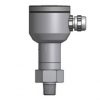Pressure Hysteresis is the difference between two separate measurements taken at the same pressure but one where the pressure was increasing and the other where the pressure was decreasing.
The hysteresis is caused by the natural reluctance of a pressure sensing material such as a diaphragm to return to its original position, shape or form after being mechanically deformed.
Featured high accuracy measurement products
 Material tension and compression testing machine pressure sensor with 1,500 psig range 4-20mA out - Ensure accurate force control in your material testing machine with this reliable and robust 1,500 psi pressure sensor.
Material tension and compression testing machine pressure sensor with 1,500 psig range 4-20mA out - Ensure accurate force control in your material testing machine with this reliable and robust 1,500 psi pressure sensor. 20 bar pressure calibrator with accuracy better than 0.5% down to 200 mbar - I am looking for a small pressure test hand pump and a couple of pressure gauges complete with fitting adaptors
20 bar pressure calibrator with accuracy better than 0.5% down to 200 mbar - I am looking for a small pressure test hand pump and a couple of pressure gauges complete with fitting adaptors
Glossary of Accuracy technical terms
- Accuracy
- BSL – Best Straight Line
- Compensated Temperature Range
- Digital Compensation
- g Effect
- Hysteresis
- LHR – Linearity, Hysteresis and Repeatability
- Long Term Stability/Drift
- NL – Non-Linearity
- PPM – Parts Per Million
- Precision
- Repeatability
- RTE – Referred Temperature Error
- Secondary Pressure Standard
- TEB – Temperature Error Band
- TEB – Total Error Band
- Temperature Compensation
- Temperature Error
- Thermal Hysteresis
- Threshold
- TSL – Terminal Straight Line
- TSS – Thermal Span or Sensitivity Shift
- TZS – Thermal Zero Shift
Help from Accuracy resources
- Pressure Sensor Accuracy Specifications
- Measurement Accuracy
- Determining calibration error of Bourdon tube pressure gauge
- What is the difference between zero offset and zero drift?


